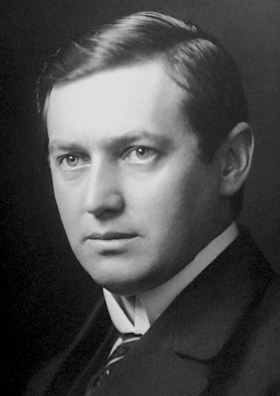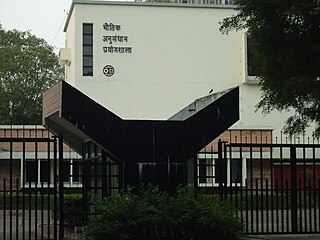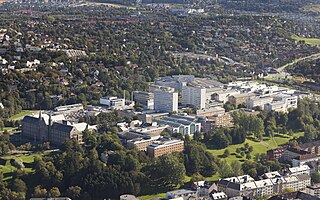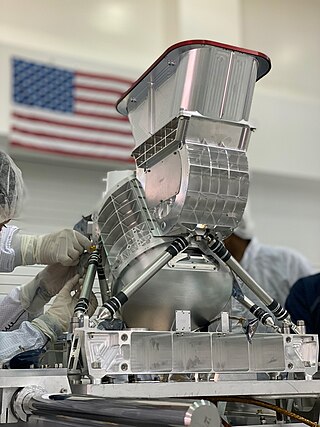
An optical spectrometer is an instrument used to measure properties of light over a specific portion of the electromagnetic spectrum, typically used in spectroscopic analysis to identify materials. The variable measured is most often the irradiance of the light but could also, for instance, be the polarization state. The independent variable is usually the wavelength of the light or a closely derived physical quantity, such as the corresponding wavenumber or the photon energy, in units of measurement such as centimeters, reciprocal centimeters, or electron volts, respectively.

The Norwegian University of Science and Technology is a public research university in Norway and the largest in terms of enrollment. The university's headquarters is located in Trondheim, with regional campuses in Gjøvik and Ålesund.

Absorption spectroscopy is spectroscopy that involves techniques that measure the absorption of electromagnetic radiation, as a function of frequency or wavelength, due to its interaction with a sample. The sample absorbs energy, i.e., photons, from the radiating field. The intensity of the absorption varies as a function of frequency, and this variation is the absorption spectrum. Absorption spectroscopy is performed across the electromagnetic spectrum.

A synchrotron light source is a source of electromagnetic radiation (EM) usually produced by a storage ring, for scientific and technical purposes. First observed in synchrotrons, synchrotron light is now produced by storage rings and other specialized particle accelerators, typically accelerating electrons. Once the high-energy electron beam has been generated, it is directed into auxiliary components such as bending magnets and insertion devices in storage rings and free electron lasers. These supply the strong magnetic fields perpendicular to the beam that are needed to stimulate the high energy electrons to emit photons.

Karl Manne Georg Siegbahn FRS(For) HFRSE was a Swedish physicist who was awarded the Nobel Prize in Physics in 1924 "for his discoveries and research in the field of X-ray spectroscopy".
SINTEF, headquartered in Trondheim, Norway, is an independent research organization founded in 1950 that conducts contract research and development projects. SINTEF has 2000 employees from 75 countries and annual revenues of three billion Norwegian kroner. SINTEF has a close partnership with Norwegian University of Science and Technology (NTNU), started in 1950 when SINTEF was founded. SINTEF has expertise in technology, medicine and the social sciences. Alexandra Bech Gjørv is the CEO of SINTEF, preceded by Unni Steinsmo, Morten Loktu and Roar Arntzen.

The Physical Research Laboratory is a National Research Institute for space and allied sciences, supported mainly by Department of Space, Government of India. This research laboratory has ongoing research programmes in astronomy and astrophysics, atmospheric sciences and aeronomy, planetary and geosciences, Earth sciences, Solar System studies and theoretical physics. It also manages the Udaipur Solar Observatory and Mount Abu InfraRed Observatory. The PRL is located in Ahmedabad.

Laboratório Nacional de Luz Síncrotron is the Brazilian Synchrotron Light Laboratory, a research institution on physics, chemistry, material science and life sciences. It is located in the city of Campinas, sub-district of Barão Geraldo, state of São Paulo, Brazil.

Gløshaugen is a neighborhood in the city of Trondheim in Trøndelag county, Norway. It is located in the borough of Lerkendal, approximately 2 kilometres (1.2 mi) southeast of Midtbyen, the downtown center of Trondheim. It is situated east of the neighborhood of Elgeseter, west of Singsaker, and north of Lerkendal.

Torbjørn Digernes is a Norwegian physicist and Professor of marine systems design.
Photothermal microspectroscopy (PTMS), alternatively known as photothermal temperature fluctuation (PTTF), is derived from two parent instrumental techniques: infrared spectroscopy and atomic force microscopy (AFM). In one particular type of AFM, known as scanning thermal microscopy (SThM), the imaging probe is a sub-miniature temperature sensor, which may be a thermocouple or a resistance thermometer. This same type of detector is employed in a PTMS instrument, enabling it to provide AFM/SThM images: However, the chief additional use of PTMS is to yield infrared spectra from sample regions below a micrometer, as outlined below.

Fourier-transform infrared spectroscopy (FTIR) is a technique used to obtain an infrared spectrum of absorption or emission of a solid, liquid, or gas. An FTIR spectrometer simultaneously collects high-resolution spectral data over a wide spectral range. This confers a significant advantage over a dispersive spectrometer, which measures intensity over a narrow range of wavelengths at a time.

Edvard Ingjald Moser is a Norwegian psychologist and neuroscientist, who is a professor at the Norwegian University of Science and Technology (NTNU) in Trondheim. In 2005, he and his then-wife May-Britt Moser discovered grid cells in the brain's medial entorhinal cortex. Grid cells are specialized neurons that provide the brain with a coordinate system and a metric for space. In 2018, he discovered a neural network that expresses a person's sense of time in experiences and memories located in the brain's lateral entorhinal cortex.

Gunnar Bovim is a Norwegian physician and civil servant. He has been the rector at the Norwegian University of Science and Technology from August 1, 2013 to August 21, 2019. After that he will be working with policy matters related to education and research at NTNU and be of disposal to NTNUs top management.

The NTH Ring is a ring worn only by graduates of the Master of Science in engineering or architecture programmes, at the Norwegian University of Science and Technology (NTNU), formerly known as NTH.
Magnus Langseth is a Norwegian researcher. He is a professor at the Department of Structural Engineering at the Norwegian University of Science and Technology (NTNU) in Trondheim, Norway. «His research is primarily related to impact and crashworthiness of aluminium and high-strength steel structures as well as lightweight ballistic protection. Included here is the development of test facilities for material testing at elevated rates of strain as well as facilities for impact and crashworthiness testing of components and structures.»

The Mapping Imaging Spectrometer for Europa (MISE) is an imaging near infrared spectrometer on board the Europa Clipper mission to Jupiter's moon Europa. MISE will examine Europa's surface composition and relate it to the habitability of its internal water ocean.

Signe Helene Kjelstrup is a Norwegian professor of physical chemistry at the Norwegian University of Science and Technology (NTNU) in Trondheim, Norway. She is a principal investigator at PoreLab, a Center of Excellence at NTNU.
Arne Halaas is a Norwegian profiled Professor emeritus in computer technology and telematics at the Norwegian University of Science and Technology (NTNU). Halaas was central in the development of the technology that led to Fast Search & Transfer ASA (FAST), which was later acquired by Microsoft for NOK 6.6 billion on April 24, 2008.

Helene Muri is a Norwegian climate scientist. She is a senior researcher for the Industrial Ecology Programme (IndEcol) at the Norwegian University of Science and Technology (NTNU), an interdisciplinary research programme specializing in environmental sustainability analysis. The programme aims to «provide high quality research and education in the field of industrial ecology for supporting the global community in realizing the Sustainable Development Goals.» Muri is also a researcher at SFI Smart Maritime. Her research interests include assessing the climate and environmental effects of various mitigation options in the maritime sector. She is a co-author in Working Groups I and III of the UN Intergovernmental Panel on Climate Change's sixth assessment report and is an adviser to the Standing Committee on Energy and the Environment of the Parliament of Norway.
















